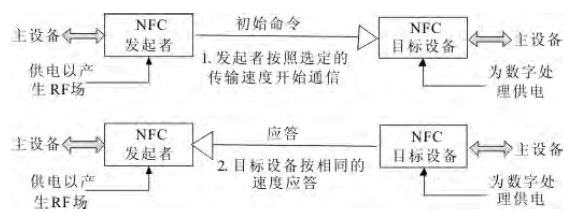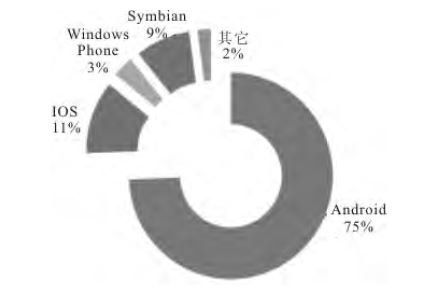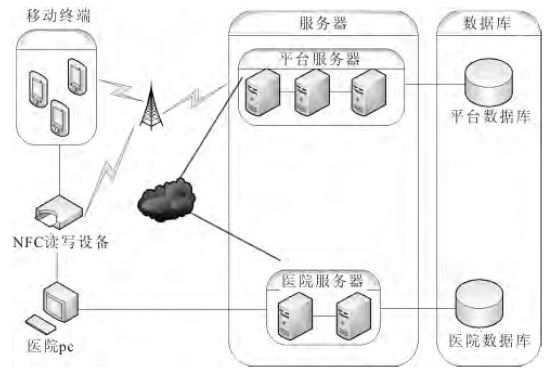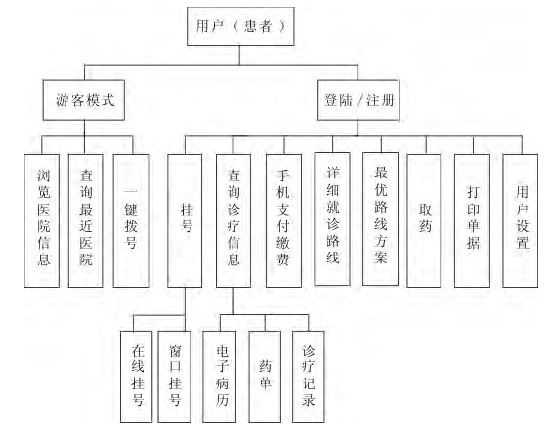With the registration of difficulties, long queues, numerous documents, no clinics, etc., the problem of medical treatment has become increasingly prominent. With the rapid development of NFC technology, namely, short-range wireless communication technology, and the popularity of Android mobile phones, mobile medical care will become an improvement in current medical treatment. A good way to combine NFC technology with the Android platform, using the M/M/c queuing model to design the optimal treatment route program class to achieve medical cardless, paperless, visual map assistance, etc., to build a mobile medical guidance doctor platform.
Since the launch of the new medical reform, the demand and development potential of China's medical and health industry informationization is huge. Residents' demand for medical and health services and products is very low, and there are many problems in China's medical and health system. Among them, the problem of difficulty in seeing a doctor is most prominent, which is reflected in the difficulty of registration, long queue time, cumbersome payment process, large hospitals, and excessive loss of documents. Mobile medical care will become a good way to improve current medical treatment. the way.
Mobile medical care is developing rapidly in foreign countries, and more and more medical and health App applications have entered people's lives. The data shows that the global mobile medical market is expected to increase from $4.5 billion to $23 billion in 2013-2017. Significant achievements at present include: “Smart Pipeline†developed by NTT DoCoMo in Japan; Mobile-Health account for Qatar Telecom dedicated to users paying for mobile medical expenses. The "good doctor" website in China has also launched the iphone client. Users can retrieve information about hospitals and doctors through their mobile phones. In Guangdong, customers can make an appointment at 12580, pay the registration fee with their mobile phone, and after receiving the QR code, they can go to the hospital self-service terminal to print the registration certificate to see the doctor. At the same time, mobile medical care has limitations in China: the lack of 3G network, the impact of Internet bandwidth restrictions, and the backwardness of equipment in primary hospitals have limited the development of mobile medical care to some extent.
However, with the popularization of NFC mobile phones and the continuous development of information technology, many mobile phones can realize the good application of NFC tag function. The mobile phone can be different in driving mode, silent mode, bedroom mode, conference mode, WLAN display and application. Switch between scene modes freely. At the Phillips Arena in the United States, customers can use NFC phones to shop, download movies, and view posters in franchise stores. In Caen, Normandy, France, residents can use NFC phones to pay at selected retail outlets, park equipment, download famous tourist attractions, movie trailers, and car schedules.
Therefore, consider combining NFC technology with the Android platform to apply it to mobile healthcare. The main functions are as follows: appointment registration, payment of medical expenses, viewing map search room, viewing hospital doctor information, viewing personal medical records, viewing the best treatment plan route, printing various documents and so on.
1 NFC technology
1.1 Basic concepts of NFC
NFC (Near Field Communication) is a short-range wireless communication technology that evolved from contactless radio frequency identification (RFID). It combines an inductive card reader, inductive card and point-to-point function on a single chip. High-frequency radio technology for identification and data exchange with compatible devices over short distances. Operating at a frequency of 13.56MHz within a distance of 10cm allows for contactless point-to-point data transmission between electronic devices. NFC terminals mainly have three working modes, and the communication process is shown in Figure 1 [1].
(1) Active mode. The NFC terminal can act as a card reader and issue a radio frequency field to identify, read/write other NFC device information.
(2) Passive mode. The NFC terminal is modeled as a card that passively responds to the RF field emitted by other devices, reading or writing information.
(3) Two-way mode. Both sides of the NFC terminal actively send out the RF field to establish peer-to-peer communication, which is equivalent to the two NFC devices are in active mode.

Figure 1 NFC communication process
1.2 Android and NFC
Android is an open source smart operating system designed by Google and has a common application in the field of mobile devices. According to Ai Media's "2013 Q2 China's smartphone market operating system distribution status" data display (see Figure 2), Android share expanded to 74.5%, currently occupying the largest market share. Android not only provides a Java-based SDK, but the source code is open.

Figure 2 2013 Q2 China smartphone market operating system distribution
NFC provides a simple, non-touch solution that allows consumers to quickly exchange information and access their content and services [2]. The combination of mobile phones and NFC technology will bring great convenience to consumers' lives, such as mobile payment, identification, mobile medical and so on. At the same time, the openness of the Android system and its powerful communication capabilities make NFC's various applications easy to implement on Android. According to China's industry information statistics, as shown in Figure 2, global NFC mobile phone shipments in 2012 will be approximately 125 million, and will reach 285 million in 2013, with a growth rate of 128%. The number of NFC mobile phones will grow rapidly in the next two years. In 2015, the penetration rate of the NFC mobile phone market will reach 51%. Moreover, many mobile phones such as Samsung, Xiaomi, Blackberry and Sony now have NFC functions.

Figure 3 NFC mobile phone factory trends in recent years
2 system structure design
2.1 Overall architecture design
The whole system adopts the client/server mode. As shown in Figure 4, the system front end includes the client and the system background. The client is mainly the mobile phone. This article uses the most popular Android system as a platform to provide the entire service to users. At the same time, the system also adopts popular NFC technology, and the NFC15693 protocol is adopted between the mobile terminal and the NFC read/write device to ensure that information can be quickly transmitted on the mobile terminal and the PC end to complete various service requirements. The PC side of the hospital is used to maintain system information and complete the docking of the foreground information, and develops using the J2EE framework. Both the mobile end and the hospital back end use TCP communication protocols to ensure stable and fast communication.
The system back-end server is built with the classic combination of Windows server 2003 + Apache + PHP + Mysql. The open source of PHP and Mysql reduces the system development cost, and the seamless connection between the two provides stable and efficient services for the front end. At the same time, the back-end also contains the database of the medical platform and the private database of each hospital to ensure the security of the hospital's private information. The separation of the platform server and the hospital's private server ensures the security of the hospital database, and also ensures the private operation of the hospital business information. Chemical.
2.2 NFC architecture supported by Android
The system uses NFC technology for fast data transmission and identity verification in window registration, clinic visit, payment of medicines, printing documents, etc. Due to short acting distance and fast response time, it is safer, simpler and faster to use NFC communication. The mobile phone can be used instead of the existing “medical card†to realize the paperlessness of documents such as cases and drug orders.
The Android system has supported NFC technology since version 2.3, and has been updated in versions 4.0, 4.1, and 4.2. Some interfaces have been added to the SDK. To support NFC functionality, Android allows applications to read data from tags and interact in NDEF (NFC Data Exchange Format) format. The NFC function implementation supported by the Android system uses a layered architecture model of package invocation.

Figure 4 overall system architecture
3 system function design
Based on NFC technology and Android system, the mobile medical guidance system is developed for the medical industry to solve the problems faced by patients in the process of seeking diagnosis and treatment, to achieve efficient, convenient and flexible medical treatment, and to achieve medical records “paperlessâ€.
The front end of the system mainly enables patients to browse hospital information, query recent hospitals, one-touch dialing, online registration, use NFC window registration, query electronic medical records, query medicine orders, use NFC to print medicine orders, online payment, detailed treatment routes, and optimal routes. Programs, etc.; the back end of the system is a doctor's end, which can realize the functions of medical record entry, drug billing, and querying the patient's historical medical record. For the platform administrator, it can perform hospital management, user management, medical record management and map management. The system function structure is shown in Figure 5.

Figure 5 system function structure
4 Optimal treatment route plan implementation
Patients arriving at the hospital are random and independent [3], and the intervals of successive arrivals are also random. The patient's arrival process generally obeys the Poisson flow, that is, the number of patients arriving at any time is the parameter λt (λ is the average arrival rate). Poisson distribution. The probability of reaching n customers in the t period is Pn(t):

The probability distribution of the interval of patient arrival is subject to a negative exponential distribution, namely:

The M/M/c queuing model means that the patient's arrival law obeys the Poisson distribution, that is, the patient's arrival interval distribution obeys the negative exponential distribution, the service time obeys the negative exponential distribution, and the service organization is c service desks. The system uses the M/M/c model to collect data in different time periods, model fitting, and applying the Excel Queueing Tool Pack in the Excel program to estimate the parameters, and obtain the fitting index of each time period and each clinic.
Through the collection of data, the M/M/c queuing model is aggregated, and the parameters to be estimated are calculated in time segments. According to the waiting number of patients going to the examination room and the corresponding service time of the clinic, the waiting time of each clinic is dynamically calculated to provide the optimal treatment route plan for the patient.
5 Conclusion
The functions provided by the system can largely solve the current ubiquitous medical problems, and the patient can easily seek medical consultation with the software. At present, NFC technology is gradually becoming mature, and its application on smartphones is increasingly widespread. The close combination of mobile medical and NFC technologies makes the system have broad application prospects.
Contemporary Style Dining Chairs
Simple and classic chair design, with PP cushion seat inner, featuring a high-density cushion seat, thick PU cover, the chair is soft and supportive, helping to relieve stress and fatigue after a long day. The metal frame has been powder coated with a black matte finish which perfectly complements the contoured shell. The slim and sturdy legs make the chair not lacking in style.
Modern Dining Chairs,Contemporary Dining Chairs,Modern Dining Room Chairs,Modern Leather Dining Chairs
Anji TianWei Steel and Plastic Products Co.,Ltd , https://www.twchair.com